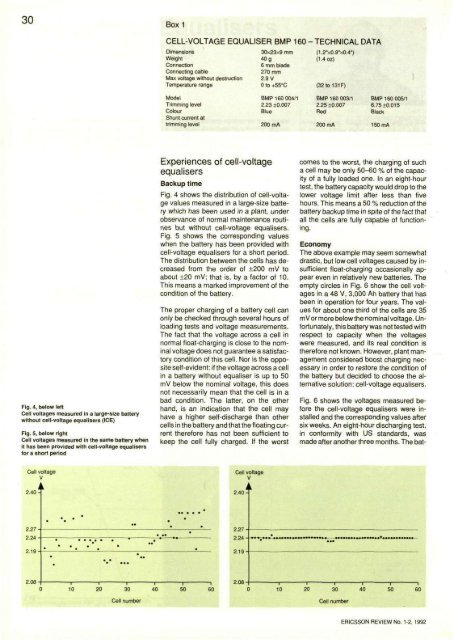Frame Relay - for Faster and More Efficient Data Communications ...
Frame Relay - for Faster and More Efficient Data Communications ...
Frame Relay - for Faster and More Efficient Data Communications ...
- No tags were found...
Create successful ePaper yourself
Turn your PDF publications into a flip-book with our unique Google optimized e-Paper software.
30Box1CELL-VOLTAGE EQUALISER BMP 160 - TECHNICAL DATADimensionsWeightConnectionConnecting cableMax voltage without destructionTemperature range30x23x9 mm40 g6 mm blade270 mm2.9 V0 to +55°C(1.2"x0.9"x0.4")(1.4 oz)(32 to 131F)ModelTrimming levelColourShunt current attrimming levelBMP 160 004/12.23 +0.007Blue200 mABMP 160 003/12.25 ±0.007Red200 mABMP 160 005/16.75 ±0.015Black150 mAFig. 4, below leftCell voltages measured In a large-size batterywithout cell-voltage equalisers (ICE)Fig. 5, below rightCell voltages measured in the same battery whenit has been provided with cell-voltage equalisers<strong>for</strong> a short periodExperiences of cell-voltageequalisersBackup timeFig. 4 shows the distribution of cell-voltagevalues measured in a large-size batterywhich has been used in a plant, underobservance of normal maintenance routinesbut without cell-voltage equalisers.Fig. 5 shows the corresponding valueswhen the battery has been provided withcell-voltage equalisers <strong>for</strong> a short period.The distribution between the cells has decreasedfrom the order of ±200 mV toabout ±20 mV; that is, by a factor of 10.This means a marked improvement of thecondition of the battery.The proper charging of a battery cell canonly be checked through several hours ofloading tests <strong>and</strong> voltage measurements.The fact that the voltage across a cell innormal float-charging is close to the nominalvoltage does not guarantee a satisfactorycondition of this cell. Nor is the oppositeself-evident: if the voltage across a cellin a battery without equaliser is up to 50mV below the nominal voltage, this doesnot necessarily mean that the cell is in abad condition. The latter, on the otherh<strong>and</strong>, is an indication that the cell mayhave a higher self-discharge than othercells in the battery <strong>and</strong> that the floating currentthere<strong>for</strong>e has not been sufficient tokeep the cell fully charged. If the worstcomes to the worst, the charging of sucha cell may be only 50-60 % of the capacityof a fully loaded one. In an eight-hourtest, the battery capacity would drop to thelower voltage limit after less than fivehours. This means a 50 % reduction of thebattery backup time in spite of the fact thatall the cells are fully capable of functioning.EconomyThe above example may seem somewhatdrastic, but low cell voltages caused by insufficientfloat-charging occasionally appeareven in relatively new batteries. Theempty circles in Fig. 6 show the cell voltagesin a 48 V, 3,000 Ah battery that hasbeen in operation <strong>for</strong> four years. The values<strong>for</strong> about one third of the cells are 35m V or more below the nominal voltage. Un<strong>for</strong>tunately,this battery was not tested withrespect to capacity when the voltageswere measured, <strong>and</strong> its real condition isthere<strong>for</strong>e not known. However, plant managementconsidered boost charging necessaryin order to restore the condition ofthe battery but decided to choose the alternativesolution: cell-voltage equalisers.Fig. 6 shows the voltages measured be<strong>for</strong>ethe cell-voltage equalisers were installed<strong>and</strong> the corresponding values aftersix weeks. An eight-hour discharging test,in con<strong>for</strong>mity with US st<strong>and</strong>ards, wasmade after another three months. The bat-ERICSSON REVIEW No. 1-2, 1992















